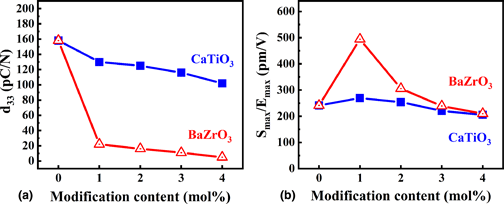Article contents
Comparing the electromechanical properties of CaTiO3- and BaZrO3-modified Bi0.5Na0.5TiO3–SrTiO3 ceramics
Published online by Cambridge University Press: 07 October 2020
Abstract

The effects of CaTiO3 (CT) and BaZrO3 (BZ) modification upon the crystal structure and electromechanical properties of lead-free Bi0.5Na0.5TiO3–SrTiO3 piezoelectric ceramics were compared within a doping range of 0–4 mol%. The different effects of CT and BZ modification upon the phase transition are clearly observed in the polarization and strain hysteresis loops. The CT-modified specimens maintain strong ferroelectricity without any abnormal enhancement in the electric field-induced strain. However, the addition of as little as 1 mol% BZ induces a transition from a nonergodic relaxor phase to an ergodic relaxor phase, thus resulting in disruption of the ferroelectric order and the generation of a high field-induced strain. The present authors believe that the substitution of large ions (such as Zr4+) into the B-sites, rather than the A-sites, of the Bi0.5Na0.5TiO3-based ceramics plays a significant role in the phase transition behavior.
Keywords
- Type
- Invited Feature Paper
- Information
- Copyright
- Copyright © The Author(s), 2020, published on behalf of Materials Research Society by Cambridge University Press
References
- 6
- Cited by



